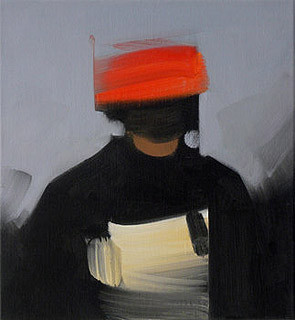Michael van Ofen
16 Nov 2007 - 11 Jan 2008
MICHAEL VAN OFEN
Michael van Ofen discovered painting at a time when its death was predicted over and over again, but in fact never occurred. With portraits, still lifes, flowers, interiors and landscapes he chooses subjects that were generally declined in the modern age. At the same time his oil paintings, reduced on few brush strokes, are far apart from the surreal figurations of the New Leipzig School or equal products of younger painter generations that are currently celebrated all over the world.
Van Ofen finds his sources in the 19th century: In addition to old masters as Frans Hals and Jacques Louis David he refers to historical tableaus of less known painters that he reinvents in precisely balanced compositions.
For van Ofen producing a painting means a careful, permanent exercising of the painting process itself: A delicate coordination of the brushwork, an elaborate setting of colour and light. The preceding analysis and dissolution of the same motive in several works serve him to prove and exercise the full range of pictorial possibilities. While painting, the figurative details decrease more and more in favour of a visualization of single brush strokes.
A single horizontally curved paint stripe remembers on a landscape some time, an oval consisting of few diagonals seems to be completed to a portrait. Nevertheless it is astonishing, how the restriction to only few tints creates such a depth of colour and atmosphere and how it puts the observer in a melancholic or mysterious mood.
In suspense between abstraction and figuration some colour parts get rid of their function to illustrate. But especially when looking at the paintings from a distance the observer gets an idea
of a situation, atmosphere, a person or known motive. Portraits and landscapes seem familiar in their allusion and simplicity, arisen from a collective memory. They indicate, but do not disclose too much and remain mysterious.
Today, the collective memory recycles images in the digital media by the Copy-and-Paste method. Michael van Ofen creates his own pictorial language by the use of existing icons that lead to general as well as to personal memories and references. His paintings may seem to be obscure, but they are more sustainable than nostalgic. His art works are far from being up-to-date but timeless in the best sense.
Michael van Ofen discovered painting at a time when its death was predicted over and over again, but in fact never occurred. With portraits, still lifes, flowers, interiors and landscapes he chooses subjects that were generally declined in the modern age. At the same time his oil paintings, reduced on few brush strokes, are far apart from the surreal figurations of the New Leipzig School or equal products of younger painter generations that are currently celebrated all over the world.
Van Ofen finds his sources in the 19th century: In addition to old masters as Frans Hals and Jacques Louis David he refers to historical tableaus of less known painters that he reinvents in precisely balanced compositions.
For van Ofen producing a painting means a careful, permanent exercising of the painting process itself: A delicate coordination of the brushwork, an elaborate setting of colour and light. The preceding analysis and dissolution of the same motive in several works serve him to prove and exercise the full range of pictorial possibilities. While painting, the figurative details decrease more and more in favour of a visualization of single brush strokes.
A single horizontally curved paint stripe remembers on a landscape some time, an oval consisting of few diagonals seems to be completed to a portrait. Nevertheless it is astonishing, how the restriction to only few tints creates such a depth of colour and atmosphere and how it puts the observer in a melancholic or mysterious mood.
In suspense between abstraction and figuration some colour parts get rid of their function to illustrate. But especially when looking at the paintings from a distance the observer gets an idea
of a situation, atmosphere, a person or known motive. Portraits and landscapes seem familiar in their allusion and simplicity, arisen from a collective memory. They indicate, but do not disclose too much and remain mysterious.
Today, the collective memory recycles images in the digital media by the Copy-and-Paste method. Michael van Ofen creates his own pictorial language by the use of existing icons that lead to general as well as to personal memories and references. His paintings may seem to be obscure, but they are more sustainable than nostalgic. His art works are far from being up-to-date but timeless in the best sense.

